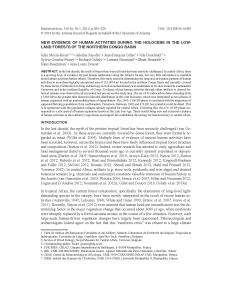Morin-Rivat J., Fayolle A., Gillet J.F., Bourland N., Gourlet-Fleury S., Oslisly R., Bremond L., Bentaleb I., Beeckman H., Doucet J.L.
In the last decade, the myth of the pristine tropical forest has been seriously challenged. In central Africa, there is a growing body of evidence for past human settlements along the Atlantic forests, but very little information is available about human activities further inland. In this study, we aimed at determining the temporal and spatial patterns of human activities in an archaeologically unexplored area of 110,000 km² located in the northern Congo Basin and currently covered by dense forest. Fieldwork involving archaeology as well as archaeobotany was undertaken in 36 sites located in southeastern Cameroon and in the northern Republic of Congo. Evidence of past human activities through either artifacts or charred botanical remains was observed in all excavated test pits across the study area. The set of 43 radiocarbon dates extending from 15,000 BP to the present time showed a bimodal distribution in the Late Holocene which was interpreted as two phases of human expansion with an intermediate phase of depopulation. The 2300–1300 BP phase is correlated with the migrations of supposed farming populations from northwestern Cameroon. Between 1300 and 670 BP, less material could be dated. This is in agreement with the population collapse already reported for central Africa. Following this, the 670–20 BP phase corresponds to a new period of human expansion known as the Late Iron Age. These results bring new and extensive evidence of human activities in the northern Congo Basin and support the established chronology for human history in central Africa.
Consultez la notice complète de l’article sur ORBi

